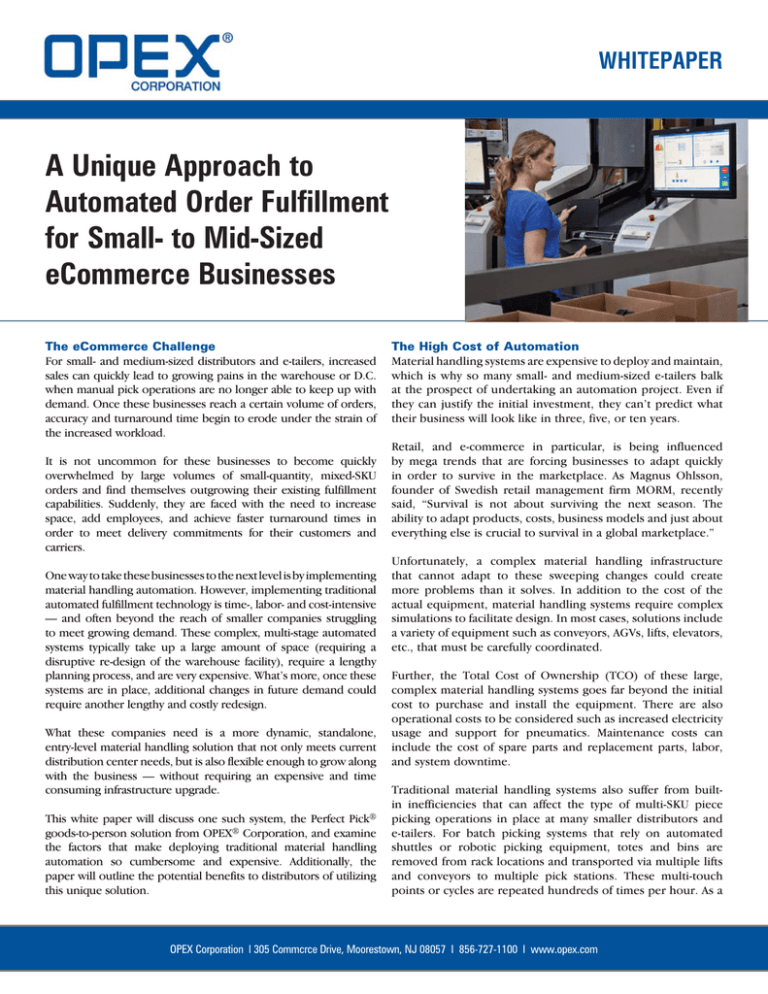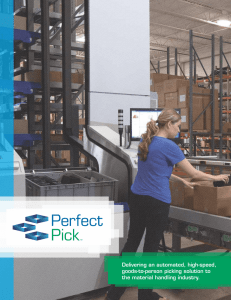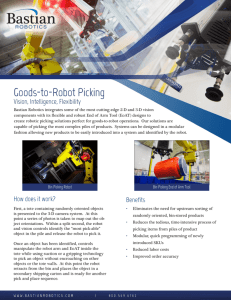A Unique Approach to Automated Order Fulfillment for Small- to Mid-Sized eCommerce Businesses
advertisement

whitepaper A Unique Approach to Automated Order Fulfillment for Small- to Mid-Sized eCommerce Businesses The eCommerce Challenge For small- and medium-sized distributors and e-tailers, increased sales can quickly lead to growing pains in the warehouse or D.C. when manual pick operations are no longer able to keep up with demand. Once these businesses reach a certain volume of orders, accuracy and turnaround time begin to erode under the strain of the increased workload. It is not uncommon for these businesses to become quickly overwhelmed by large volumes of small-quantity, mixed-SKU orders and find themselves outgrowing their existing fulfillment capabilities. Suddenly, they are faced with the need to increase space, add employees, and achieve faster turnaround times in order to meet delivery commitments for their customers and carriers. One way to take these businesses to the next level is by implementing material handling automation. However, implementing traditional automated fulfillment technology is time-, labor- and cost-intensive — and often beyond the reach of smaller companies struggling to meet growing demand. These complex, multi-stage automated systems typically take up a large amount of space (requiring a disruptive re-design of the warehouse facility), require a lengthy planning process, and are very expensive. What’s more, once these systems are in place, additional changes in future demand could require another lengthy and costly redesign. What these companies need is a more dynamic, standalone, entry-level material handling solution that not only meets current distribution center needs, but is also flexible enough to grow along with the business — without requiring an expensive and time consuming infrastructure upgrade. This white paper will discuss one such system, the Perfect Pick® goods-to-person solution from OPEX® Corporation, and examine the factors that make deploying traditional material handling automation so cumbersome and expensive. Additionally, the paper will outline the potential benefits to distributors of utilizing this unique solution. The High Cost of Automation Material handling systems are expensive to deploy and maintain, which is why so many small- and medium-sized e-tailers balk at the prospect of undertaking an automation project. Even if they can justify the initial investment, they can’t predict what their business will look like in three, five, or ten years. Retail, and e-commerce in particular, is being influenced by mega trends that are forcing businesses to adapt quickly in order to survive in the marketplace. As Magnus Ohlsson, founder of Swedish retail management firm MORM, recently said, “Survival is not about surviving the next season. The ability to adapt products, costs, business models and just about everything else is crucial to survival in a global marketplace.” Unfortunately, a complex material handling infrastructure that cannot adapt to these sweeping changes could create more problems than it solves. In addition to the cost of the actual equipment, material handling systems require complex simulations to facilitate design. In most cases, solutions include a variety of equipment such as conveyors, AGVs, lifts, elevators, etc., that must be carefully coordinated. Further, the Total Cost of Ownership (TCO) of these large, complex material handling systems goes far beyond the initial cost to purchase and install the equipment. There are also operational costs to be considered such as increased electricity usage and support for pneumatics. Maintenance costs can include the cost of spare parts and replacement parts, labor, and system downtime. Traditional material handling systems also suffer from builtin inefficiencies that can affect the type of multi-SKU piece picking operations in place at many smaller distributors and e-tailers. For batch picking systems that rely on automated shuttles or robotic picking equipment, totes and bins are removed from rack locations and transported via multiple lifts and conveyors to multiple pick stations. These multi-touch points or cycles are repeated hundreds of times per hour. As a OPEX Corporation l 305 Commcrce Drive, Moorestown, NJ 08057 l 856-727-1100 l www.opex.com whitepaper result, there are multiple points of failure established between the bin/tote location and the person who ultimately picks the product or packages it for shipment. That not only creates potential bottlenecks in the system, but also introduces more opportunities for errors during the picking process. A system that streamlines the flow of goods between the shelf location and the picker can make the process more efficient and accurate, which can help businesses increase shipment velocity while reducing the overall cost of automation. A Unique Goods-to-Person Approach To address the needs of small- and medium-sized distribution facilities experiencing high picking volume, OPEX has designed Perfect Pick, a unique automated, high-speed, goods-to-person picking solution that was designed to eliminate the complexities associated with traditional fulfillment technologies. Perfect Pick is a standalone system that is comprised of a scaleable, high-density tote racking infrastructure, along with a fleet of autonomous, robotic delivery vehicles, iBOTs®, that can access every tote location within the aisle, both vertically and horizontally. Goods are delivered directly to the pick station at one or both ends of the aisle, where they can be kitted or packaged for shipment. This direct interface eliminates the need for complex conveyor systems or transfer equipment, such as elevators or lifts, typically used for accumulating and sorting batch picks. This solution is ideal for high-volume, small SKU count operations typical of a small- or mid-sized e-commerce business. “One of the key factors that makes this solution unique and feasible — and feasibility is critical — is that the iBOT brings the goods directly to the person,” says John Kemp, owner of Kemp Systems & Associates, a Milwaukee-based company that specializes in space and workflow improvement services for warehouses and industrial facilities. This goods-to-person approach means the system takes up less physical space than a complex material handling solution, costs less to operate, takes less time to design and deploy, and can quickly scale-up to handle high pick volumes. Rather than relying on multiple frontend lifts, transfer devices, and other interface points to deliver goods to pick locations, the Perfect Pick system relies on autonomous iBOTs that can pick up a tray, tote or box (up to 60 lbs.), deliver it to the picking station, and then return it to a location within the racking system. Multiple iBOTs are typically deployed per aisle as throughput dictates, and each one of them can access 100 percent of the inventory. In traditional systems, shuttles are restricted to a specific row or storage level, thereby limiting their potential utilization capacity across the entire aisle. At the heart of the Perfect Pick solution is the traffic control software, which monitors the position of all iBOTs and directs their movement in the aisle to ensure full resource optimization and operational efficiency. Because each iBOT can move both horizontally and vertically, they have access to every SKU location within the system. When the iBOT presents at the pick station, it tilts for ergonomic positioning to reduce strain and produce a more comfortable environment for the employee. Text, visual prompts and pickto-light indicators direct the picker to select the right item from the tote, and indicates which box it should be placed in. Once the pick is completed, the iBOT is released to return the tote to a location in the racking structure. The next iBOT is immediately presented to begin the next picking sequence. By eliminating the multiple interface points required by traditional systems, and by streamlining the picking process, this goods-to-person solution saves time, improves throughput, and eliminates numerous points of failure, chokepoints, and opportunities for incorrect picks to enter the system. Perfect Pick can generate a throughput rate of up to 1,000 picking cycles (picking and putting) per hour, all within a small operational area. Benefits A standalone, goods-to-person material handling solution provides a number of benefits for smaller distributors, including a number of key cost reductions, a lower total cost of ownership, and efficiency improvements that can directly affect throughput and staffing needs. Primary benefits include: Picking Efficiency: By bringing goods directly to the pick station, Perfect Pick can dramatically decrease the amount of walking in a large warehouse or distribution center. In many OPEX Corporation l 305 Commcrce Drive, Moorestown, NJ 08057 l 856-727-1100 l www.opex.com whitepaper smaller warehouses, picking is almost entirely manual. According to some estimates, just walking the warehouse floor makes up 75 to 80 percent of order picking time. That walking is hard on employees, and is highly inefficient. By bringing goods to the pick station automatically, companies can dramatically increase throughput, reduce wasted walk time, and improve working conditions for employees. One to two people can pick all of their orders from one of these standalone systems, without any walking or searching. The iBOTs are continually delivering at high rates of speed directly to the picking station. Parts are delivered as fast as they can be picked; that means an entire order can be picked at once without the need for batching items and separating them later, and without using conveyors to ferry items to multiple pick stations. “That speed of delivery to the person, bringing the tote to the picker without them walking around the warehouse to pick orders, can allow businesses to reduce the number of people required for picking a given volume from four to one,” Kemp says. The system can reduce the number of pickers, while offering staff a comfortable, ergonomically designed interface that can reduce the physical strain of traditional person-to-goods pick models. Thus, it could also potentially help reduce employee turnover among the labor force. Better Space Utilization: Traditional automation systems require more space than a small warehouse or distribution center can typically provide; that means the owner would either need to expand the facility, reconfigure the facility, or move to a new building. The Perfect Pick solution is self-contained and configured in relatively narrow aisles that make good use of vertical space. Minimizing the use of conveyors in the order picking solution also provides more space and travel flexibility within the facility. Ease of Installation: A traditional material handling system could take up to 15 months to design, simulate, and deploy. A standalone solution can be installed quickly and relatively easily with minimal disruption to existing warehouse operations — in a matter of a few months. For rapidly growing companies that need to rapidly upgrade their fulfillment capabilities, the ability to ramp up quickly is critical. “The standalone Perfect Pick is simple in design and functionality, eliminating months of engineering. These are truly great advantages over traditional automated systems,” Kemp says. Redundancy: In a traditional material handling system, the failure of a single conveyor or exchange point can shut down the entire operation. Bottlenecks can also occur if product volume changes unexpectedly. With a self-contained system, there is inherent redundancy. If an iBOT needs to be taken out of the system, it can simply be removed or replaced in a matter of minutes without impacting the overall operation of the system. Improved Accuracy: An e-Commerce order typically includes one to three items per order from a large number of SKUs. By reducing the number of touchpoints in the material handling system, this type of solution can reduce picking errors. Energy Efficiency: Material handling equipment can require a tremendous amount of electricity, which increases the overall TCO of the system. A standalone solution can eliminate the energy costs associated with operating multiple lifts, elevators, and conveyors. Additionally, the iBOTs utilize onboard ultra-capacitors to recapture energy during deceleration and descent, and store that energy to propel the iBOTs during the picking process. According to OPEX, the solution uses less than 50 percent of the energy required for competing technologies. OPEX Corporation l 305 Commcrce Drive, Moorestown, NJ 08057 l 856-727-1100 l www.opex.com whitepaper It is also worth noting that since OPEX is a net-zero user of electricity as a result of their 2.4 MW solar power system installation, every Perfect Pick is manufactured using 100 percent renewable energy from the sun. Flexibility: Many distribution facilities, particularly those operated by retailers and e-tailers, face a considerable amount of seasonality in their business. There can be large swings in demand that, in many facilities, are addressed by throwing money and labor at the problem. In 2013, stores and distribution centers were expected to add 665,800 seasonal workers, according to consulting firm Challenger, Gray & Christmas. Amazon alone planned to hire 70,000 full-time seasonal workers at its facilities to support operations during the holiday season. During these fluctuations, the Perfect Pick solution can expand its throughput simply by adding more iBOTs to the system, thereby adding capacity without the expense of hiring and training temporary employees. In situations where long-term growth dictates expansion, throughput can also be increased by expanding the rack system or adding a back-end pick station. “As I see it, every iBOT is worth three people,” Kemp says. “They can work three shifts per day and five-plus days per week, and they can work faster than a person on that shift. You can significantly boost throughput in a 24-hour period during those peak times. “It can be implemented quickly, and it’s flexible enough to allow you to increase throughput later on,” Kemp continues. “You have that simplicity of implementation, no need for simulation, flexibility for future requirements, and you can still store thousands of totes in one aisle. That’s impressive.” Conclusion Implementing or upgrading an automated material handling system is a daunting undertaking, particularly for smalland medium-sized distributors that may not have the time, money, and other resources required to implement and support these large, complex systems. The availability of a lower-cost, standalone system that can enable more efficient and accurate picking makes automation feasible for companies that would have previously considered it beyond their reach. As same-day and next-day shipping becomes the norm across vertical markets, picking efficiency has never been more critical. Using the goods-to-person approach of the Perfect Pick model, distributors and e-tailers can increase throughput, decrease downtime, and rapidly expand their fulfillment capacity at a lower cost than ever before. About OPEX Corporation OPEX Corporation is a recognized global technology leader in document imaging, high-speed mailroom automation, and material handling. Since 1973, OPEX systems have provided performance enhancing workflow solutions and cost-effective results to thousands of organizations worldwide. Today, OPEX systems are installed in financial services, healthcare, government, non-profit, utility, service bureau, insurance, telecommunications, and educational marketplaces around the world. For more information, visit www.opex.com. OPEX Corporation l 305 Commcrce Drive, Moorestown, NJ 08057 l 856-727-1100 l www.opex.com




